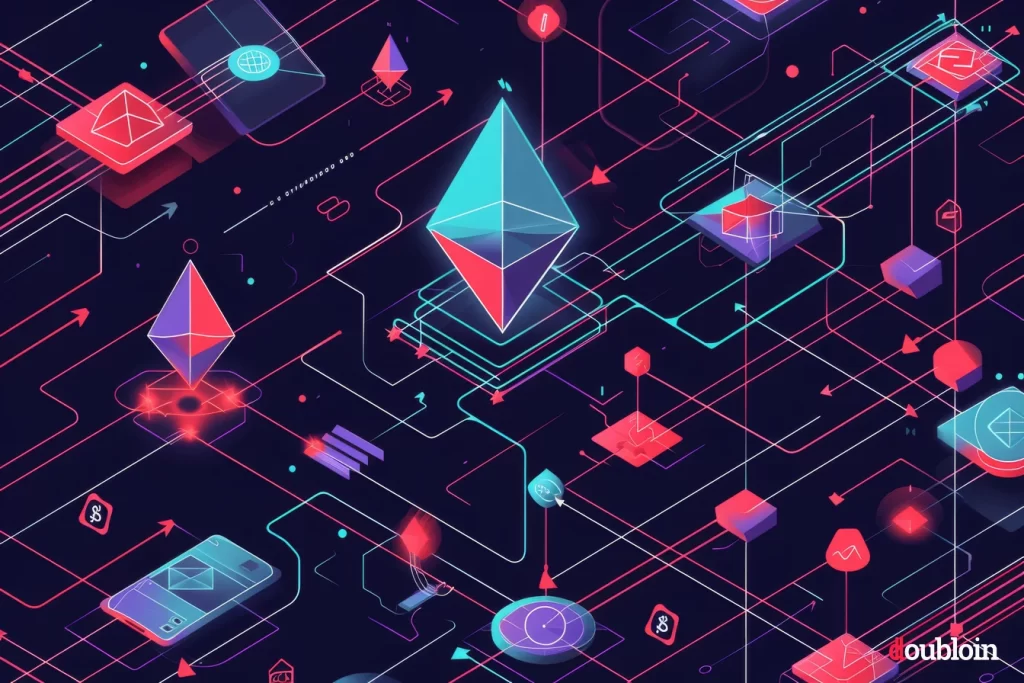
MATIC is the key part of the Polygon network. This network aims to make Ethereum blockchain transactions quicker and cheaper without losing security. Polygon uses a mix of Plasma Framework and proof-of-stake (PoS) mechanisms. This makes it a link for networks that work with Ethereum.
As you learn more, you’ll see how this mix strengthens and grows Ethereum’s environment. It brings up important questions about the future of decentralized apps (dApps) and digital assets.
This exploration will give you a detailed view of how Polygon’s new methods are changing the blockchain world.
Key Takeaways
- Polygon (MATIC) significantly enhances Ethereum by improving transaction speed and reducing costs.
- The MATIC token is central to network security, incentivizing validators and powering the ecosystem.
- Polygon’s advanced architecture and innovations, including Polygon 2.0 and the SDK, offer scalable and interoperable solutions for developers.
- Staking MATIC secures the network and rewards participants, fostering a robust and decentralized ecosystem for DeFi and dApps growth.
Introduction to Polygon (MATIC): A Comprehensive Ethereum Scaling Solution
Polygon (MATIC) is a revolutionary solution that tackles Ethereum’s scalability issues. It speeds up transactions and reduces costs without sacrificing security.
As a top Ethereum scaling solution, Polygon uses a multi-layered architecture. This allows for smooth interactions between old Ethereum-based apps and new infrastructures. Polygon helps ease the congestion on the Ethereum blockchain. It ensures transactions are quick and cheap.
The MATIC token is vital to the ecosystem. It supports the network’s operations and rewards validators. With advanced technology and a progressive strategy, Polygon is a strong solution.
What is MATIC? Understanding the Currency Behind Polygon

As the backbone of Polygon, an ethereum-compatible blockchain, MATIC operates as more than just a cryptocurrency.
It’s a key component in maintaining the network’s security and efficiency. Validators receive MATIC as a reward for verifying transactions and maintaining the blockchain’s integrity. This mechanism ensures a robust, decentralized system.
For users, MATIC facilitates low-cost, high-speed transactions across Polygon’s infrastructure. Its utility extends beyond simple transfers, powering smart contracts and decentralized applications (DApps) on this expansive network.
The Architecture of Polygon Network: An Ethereum Multi-Chain Framework

This section will explore the innovations and enhancements introduced with Polygon 2.0, focusing on how they redefine scalability and interoperability within the ecosystem.
You’ll also gain a deep understanding of the MATIC token, examining its utility and value in facilitating transactions and governance on this multi-chain framework.
Innovations and Enhancements in Polygon 2.0
With the introduction of Polygon 2.0, the network undergoes significant architectural advancements, enhancing its position as a leading Ethereum multi-chain framework.
You’ll witness a notable elevation in its capabilities, directly influencing the future of Polygon and its ecosystem.
Here are key innovations:
- Polygon Software Development Kit (SDK): A modular, flexible framework that enables building and connecting secured chains like Plasma, Optimistic Rollups, and zk-Rollups.
- Scalability: Enhanced algorithms boost scalability, significantly increasing transactions per second without compromising security.
- Transactions Per Second (TPS) Increase: Implementation of cutting-edge technologies to support thousands of transactions per second, reducing congestion and fees.
- Future of Polygon: These innovations ensure Polygon’s robustness, preparing it for widespread adoption and complex applications, marking a pivotal moment in its evolution.
Understanding the MATIC Token: Utility and Value
At the core of Polygon’s multi-chain framework lies the MATIC token, serving as the backbone for transaction processing and governance within this expansive ecosystem.
As the native cryptocurrency of the Polygon blockchain, the MATIC token embodies both utility and value.
It’s not merely a digital asset; it’s the lifeblood that powers the intricate operations across Polygon’s network. You’ll find it used to pay transaction fees, a critical mechanism ensuring the network remains efficient and secure.
Beyond its role in fueling transactions, MATIC also empowers you with governance rights, allowing you to participate in key decision-making processes that shape the network’s future. This dual functionality underscores not only the token’s intrinsic value but also its pivotal role in maintaining the Polygon ecosystem’s health and vibrancy.
How Does Polygon Work? A Deep Dive into Its Operations

You’ll find that Polygon operates through a nuanced blend of speed, efficiency, and cost-effectiveness in its transaction processing.
The interplay between validators and delegators underpins its Proof of Stake (PoS) mechanism, ensuring network security and consensus.
This system not only optimizes transaction throughput but also balances the demands of decentralization and scalability.
Transactions on Polygon: Speed, Efficiency, and Cost
Understanding the mechanisms behind transactions on Polygon reveals a landscape where speed, efficiency, and cost are intricately balanced to optimize user experience.
Here’s a deep dive:
- Transaction Speed: Polygon uses a unique layer 2 scaling solution, significantly increasing transaction throughput compared to the Ethereum network.
- Transaction Fees: By leveraging this layer, Polygon achieves much lower transaction fees, making micro-transactions viable.
- Ethereum Network Compatibility: Despite its efficiency, Polygon maintains compatibility with Ethereum, ensuring seamless asset transfers and smart contract executions.
- Layer Efficiency: The layer approach not only boosts speed but also enhances overall network efficiency, enabling a smoother experience for developers and users alike.
This balanced approach ensures that Polygon remains a compelling choice for those prioritizing speed, cost-effectiveness, and efficiency in their blockchain interactions.
The Role of Validators and Delegators in Polygon PoS
Building on the efficient transaction processes of Polygon, it’s crucial to explore how validators and delegators play pivotal roles in maintaining the network’s security and performance within its Proof of Stake (PoS) framework.
In Polygon PoS, validators are responsible for processing transactions and proposing new blocks to the chain. They’re selected based on the amount of MATIC they stake, aligning their incentives with the network’s integrity.
Delegators, on the other hand, contribute to the consensus mechanism indirectly by staking their MATIC with validators they trust. This collaboration enhances the security and decentralization of the network.
The consensus mechanism of Polygon’s PoS ensures that as long as validators and delegators act in the network’s best interest, they’re rewarded, fostering a robust, trustless ecosystem.
Polygon and Ethereum: A Synergistic Relationship

You’ll find that Polygon’s role as a Layer 2 solution significantly enhances Ethereum’s scalability, addressing critical network congestion and high transaction fees.
By staking on Polygon, you’re not only securing the network but also tapping into a system of rewards that bolsters both your assets and the ecosystem’s robustness.
This interplay between Polygon and Ethereum exemplifies a synergistic relationship, crucial for advancing blockchain technology and its widespread application.
Layer 2 Solutions and Scaling Ethereum
As you delve deeper into the synergy between Polygon (MATIC) and Ethereum, it’s crucial to understand how this relationship fosters a more efficient, scalable, and user-friendly environment for smart contract deployment and execution.
Here’s what you need to know:
- Polygon acts as a scalability enhancer, significantly reducing transaction fees and processing times on the Ethereum network.
- It employs a multi-chain framework, allowing for seamless interoperability between Ethereum and various other blockchains.
- Optimistic Rollups and zk-Rollups are utilized to batch transactions, further amplifying Ethereum’s throughput.
- Smart contract execution becomes more efficient, with Polygon providing developers a robust platform for dApp development and deployment without leaving the Ethereum ecosystem.
Staking on Polygon: Mechanics and Rewards
By engaging in the proof-of-stake process, network participants lock up Matic, the native token of Polygon, as a form of security deposit.
This act, known as staking, plays a pivotal role in the operational efficiency and security of the Polygon network.
Staked Matic tokens serve multiple purposes: they validate transactions, secure the network, and generate rewards for the stakeholders, aligning incentives across the ecosystem. The rewards are distributed proportionally to the amount of Matic staked, incentivizing users to contribute to the network’s robustness.
Buying, Staking, and Trading MATIC

Setting up a Polygon wallet is your next critical step, demanding technical proficiency to ensure secure storage and seamless transactions within the Polygon ecosystem.
How to Buy Polygon (MATIC) and Where
To effectively acquire Polygon (MATIC), you’ll need to understand the various platforms and strategies for buying, staking, and trading this versatile cryptocurrency.
Here’s a detailed breakdown:
- Choose a Reliable Exchange: Opt for reputable cryptocurrency exchanges like Coinbase to buy MATIC. These platforms offer a secure environment and straightforward purchasing processes.
- Research Market Conditions: Analyze current market trends and prices before you buy Polygon. This ensures you make informed decisions.
- Consider a Polygon Wallet: For long-term holding, transferring your MATIC to a Polygon wallet ensures enhanced security and control over your assets.
- Explore Staking Options: Staking MATIC on certain platforms can yield rewards, offering an additional incentive beyond potential price appreciation.
Setting Up a Polygon Wallet: A Step-by-Step Guide
To begin, select a reputable wallet that supports MATIC on the Polygon network. After installation, secure your wallet with a strong password and backup your recovery phrase.
To interact with the Polygon ecosystem, you’ll need to use the official Polygon Bridge. This bridge facilitates the transfer of MATIC between the Ethereum blockchain and the Polygon network. By doing so, you can receive MATIC directly in your Polygon wallet, ready for trading or staking.
For selling MATIC, access the bridge to transfer your tokens back to the Ethereum network or utilize a compatible exchange that supports direct trading of MATIC on the Polygon network. Always prioritize security by double-checking URLs and using the official Polygon bridge for transactions.
The Ecosystem of Polygon: dApps, DeFi, and Beyond

The exponential growth of DeFi on Polygon, characterized by increased liquidity and user adoption, underscores its pivotal role in the blockchain ecosystem.
This surge not only reflects the network’s robust infrastructure but also highlights the evolving landscape of decentralized finance, setting new benchmarks for speed, security, and interoperability.
Exploring dApps on the Polygon Network
The seamless integration between Ethereum and Polygon enhances scalability and interoperability, making it an ideal playground for developers and users alike.
Here, MATIC, Polygon’s native cryptocurrency, plays a pivotal role in facilitating transactions and governance within this bustling blockchain environment.
To grasp the depth of innovation on Polygon, consider these key areas:
- Scalability Solutions: Leveraging Layer 2 technologies for faster, cheaper transactions.
- Cross-Chain Interoperability: Bridging assets between Ethereum and Polygon.
- Decentralized Marketplaces: Empowering creators and consumers in a trustless ecosystem.
- Gaming and NFT Platforms: Revolutionizing entertainment and digital ownership on the blockchain.
The Growth of DeFi on Polygon
Built on the Matic network, this ecosystem leverages Polygon’s architecture to facilitate transactions at significantly lower costs, while maintaining high throughput and near-instantaneous finality.
This technical prowess is crucial for DeFi applications, where speed and cost can greatly influence user experience and accessibility.
The diverse use cases encompassed within Polygon’s DeFi landscape, from lending and borrowing platforms to decentralized exchanges (DEXs), illustrate the network’s adaptability and scalability.
Developers are attracted to Polygon for its robust infrastructure that supports complex smart contracts and dApps, ensuring a seamless integration of traditional financial systems with blockchain technology.
The Future of Polygon: Trends, Challenges, and Opportunities

Understanding Polygon’s current market position and untapped potential requires a thorough analysis of its competitive landscape, including the strengths, weaknesses, and unique opportunities it faces.
This examination will equip you with a nuanced perspective on Polygon’s capacity to navigate challenges and seize opportunities in the evolving crypto ecosystem.
Innovations and Roadmap: What’s Next for Polygon?
Several transformative innovations and a strategic roadmap position Polygon at the forefront of blockchain evolution, offering a glimpse into future trends, challenges, and opportunities in this dynamic space:
- Scalability Solutions: Implementing state-of-the-art protocols to enhance transaction speed and efficiency.
- Interoperability Features: Facilitating seamless communication across different blockchain networks.
- Sustainability Initiatives: Advancing eco-friendly practices to minimize the blockchain’s carbon footprint.
- Governance Models: Introducing decentralized governance structures to empower community participation.
These initiatives aren’t just expanding Polygon’s capabilities but are setting new standards for the entire blockchain network.
With such a robust roadmap, Polygon (MATIC) is poised for significant growth, addressing both current challenges and seizing future opportunities.
Analyzing the Market: Polygon’s Position and Potential
Building on the strategic innovations outlined, let’s now explore how these advancements position Polygon in the competitive landscape and its potential for future growth amidst evolving market trends and challenges.
| Factor | Polygon Crypto | Market Position |
|---|---|---|
| Current Price | Competitive | Favorable |
| Technological Edge | High | Strong |
| Polygon vs Others | Leading | Advancing |
| Potential Growth | High | Promising |
Polygon’s market position is increasingly favorable, primarily due to its competitive current price and technological edge.
When comparing Polygon vs others, it’s clear that its advancements provide a strong footing in the competitive landscape. The potential for growth remains high, with market trends indicating an expanding demand for scalable and efficient blockchain solutions. Understanding these dynamics is crucial for grasping Polygon’s future trajectory in the crypto ecosystem.
Investing in Polygon: Understanding the Risks and Rewards

Understanding Polygon’s long-term vision, including its technological advancements and strategic partnerships, can illuminate why MATIC might be a wise investment.
However, you must weigh these potential rewards against the inherent risks of cryptocurrency investments, such as regulatory changes and market sentiment shifts.
The Current Price of MATIC and Market Analysis
Understanding Polygon’s (MATIC) current market position requires a thorough analysis of its recent price trends and the broader cryptocurrency market’s dynamics, emphasizing the risks and rewards of investing in this digital asset.
- Current Price of MATIC: The latest price movements of MATIC on the Polygon network provide insight into its volatility and potential growth.
- Market Analysis: A deep dive into crypto markets reveals where MATIC stands among popular crypto assets, highlighting its liquidity and market cap.
- Volatility Factors: External factors influencing the crypto markets can significantly impact MATIC’s price, from regulatory news to technological advancements.
- Investment Risks and Rewards: Understanding the inherent risks and potential rewards tied to MATIC’s performance in the current market scenario is crucial for informed investing.
The Long-Term Vision: Why Polygon MATIC Could Be a Wise Investment
Polygon aims to revolutionize blockchain usability by making transactions faster and cheaper, a critical factor for mass adoption.
Its long-term vision to decentralize the internet, creating a more equitable digital landscape, positions it uniquely in the cryptocurrency market. Investors who use Polygon not only bet on the technology but also on its widespread adoption across decentralized applications.
Polygon’s Impact on Cryptocurrency: Scalability, Adoption, and the Future

You’ve observed Polygon’s significant strides in enhancing blockchain scalability and fostering adoption, but how does it stack up against other scaling solutions?
By examining case studies of successful projects and partnerships, you’ll gain insights into Polygon’s unique value proposition in the crypto ecosystem.
A comparative analysis with its competitors will shed light on why Polygon has emerged as a pivotal player in shaping the future of cryptocurrency.
Case Studies: Successful Projects and Partnerships on Polygon
Let’s explore how Polygon’s strategic partnerships and successful projects have significantly enhanced cryptocurrency’s scalability, adoption, and outlook for the future.
By leveraging the Matic network, these initiatives have demonstrated Polygon’s capability to address critical challenges within the blockchain ecosystem.
- Decentraland: Utilizing Polygon for a seamless user experience in virtual real estate transactions, showcasing scalability.
- Aavegotchi: A DeFi-centric NFT project on Polygon, highlighting the successful integration of finance and collectibles.
- SushiSwap: This partnership expanded Polygon’s DeFi ecosystem, enhancing transaction speed and reducing costs.
- OpenSea: Integration with Polygon to offer gas-free NFT listings, improving market accessibility and fostering widespread adoption.
These case studies underscore Polygon’s pivotal role in advancing blockchain technology, setting a benchmark for future projects and partnerships.
Polygon vs. Other Scaling Solutions: A Comparative Analysis
Unlike traditional layer-2 solutions that act as a mere sidechain to ETH, Polygon positions itself as a multi-chain system.
This framework allows it to process transactions on multiple blockchains simultaneously, significantly reducing congestion and lowering transaction fees on the main Ethereum network.
Moreover, its compatibility with Ethereum’s existing infrastructure enables developers to deploy dApps with minimal changes, fostering a seamless transition and broader adoption.
By prioritizing a multifaceted approach to scalability—combining Plasma, PoS sidechains, and zk-rollups—Polygon outpaces singular solution competitors, ensuring its pivotal role in the future scalability and widespread adoption of cryptocurrencies.
Conclusion: Why Polygon MATIC Matters in the Crypto Space
Polygon MATIC dramatically enhances Ethereum’s scalability and efficiency, marking its critical role in the broader crypto ecosystem.
As you delve into why Polygon is a cornerstone in digital assets, consider these points:
- Polygon is a layer that operates alongside the Ethereum blockchain, offering a scalability solution without compromising security.
- Known as MATIC, it’s an ERC-20 token, integral for transaction fees and staking on the Polygon network.
- By improving transaction speed and reducing costs, it makes using crypto assets more viable for everyday applications.
- Its multi-chain architecture enables interoperability among different blockchain platforms, fostering a more connected and efficient digital asset space.
Frequently Asked Questions
How Does Polygon (MATIC) Address Environmental Concerns Associated With Blockchain Technology, and What Sustainability Initiatives Are in Place?
Polygon tackles environmental issues by implementing energy-efficient consensus mechanisms, reducing blockchain’s carbon footprint. It’s committed to sustainability, actively pursuing green initiatives and partnerships to enhance its eco-friendly approach in the blockchain space.
What Are the Specific Security Measures Implemented by Polygon to Protect Against Hacks and Vulnerabilities in Its Network?
You’re exploring Polygon’s security, focusing on measures like Heimdall and Bor – layers enhancing network security. They utilize Proof of Stake (PoS) mechanisms and implement cryptographic techniques to safeguard against hacks and vulnerabilities.
Can Existing Ethereum Smart Contracts Be Seamlessly Migrated to Polygon, and What Are the Technical Steps Involved in Such a Migration?
Yes, you can migrate Ethereum smart contracts to Polygon with minimal changes. The process involves deploying your contract to Polygon’s network, adjusting for gas fees, and possibly using Polygon’s bridges for asset transfers.
How Does the Governance Model of Polygon Work, and What Role Do MATIC Token Holders Play in the Decision-Making Process?
In Polygon’s governance model, you, as a MATIC token holder, have significant influence in decision-making. You’ll vote on proposals and protocol changes, ensuring the network’s direction aligns with your vision and the community’s needs.
What Kind of Support and Resources Are Available for Developers Looking to Build on the Polygon Platform, Especially Those New to Blockchain Technology?
You’ll find comprehensive resources and support, including SDKs, APIs, and documentation. For beginners, there are tutorials and community forums where you can dive deep into blockchain technology and develop your project efficiently on Polygon.




